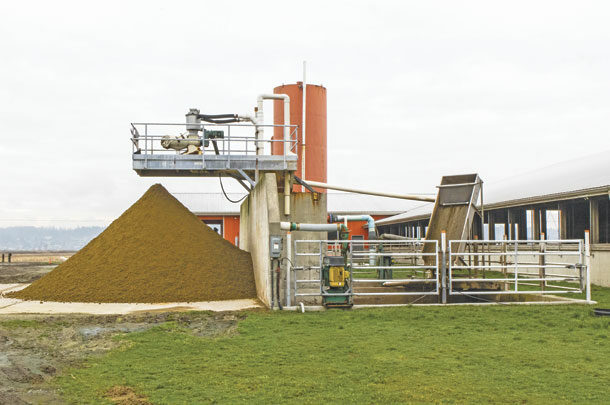The nutrient density of manure is one of the most important factors influencing transportation costs. As the largest part of the manure slurry is water, it is natural to consider separation and partitioning strategies that divide the slurry into different fractions.
One fraction would be nutrient-dense and could be more economically transported away from the animal production facility, and the other fraction would have a low nutrient content that would be applied at high rates on land near the production facility.
However, if a producer is going to add a nutrient-partitioning technology to their manure management system, the costs associated with the installation and use of the system need to be recovered.
Potential economic benefits associated with nutrient-partitioning technology could include reduced transport and land application costs, smaller manure storages (if a system where the low-nutrient fraction could be irrigated onto the land more frequently could be developed) or potentially the recovery of a bedding product that could be recycled for on-farm use.
Alternatively, farms can focus resources toward constructing infrastructure that helps in moving manure from farm to fields, such as permanent pipelines or in-field loading stations to help support the use of large tanks for in-field loading of application equipment.
Again, to support these investments, a farm would need to anticipate that, over the next few years, they could recoup their costs via savings in manure application costs. Given these options, how should a farm think about which option, if either, is a better fit for their operation?
In terms of nutrient separation systems, the original cost of manure transport and land application can be compared to the costs of transport and land application when differing levels of manure treatment were obtained. This, then, gives the performance and cost relationship the nutrient-partitioning systems would have to achieve to be a viable option to implement in the farm’s manure management systems.
To do this, a model of how application costs vary with manure application rate and transport distance is needed; this could be as simple as knowing your application price is 1 cent per gallon with a 0.1 cent per gallon per mile moved and the relative distances of the fields to which you apply or could take into account how application rate may impact the price.
In many cases, the actual costs are strongly influenced by distance from the barn to the field driveway, as well as variables like the size of the field and how a draghose could be routed, or the path tank wagons would have to take to get manure from the storage to the land application area, or even the number of times the draghose would have to be set and moved to cover the application area, along with numerous other things, but even a rough approximation like this can let us know if we are in the ballpark.
To illustrate this concept, let’s say we are a 2,000-head dairy with cows making manure at a typical rate, and our manure management plan is based on nitrogen-limited application rates. If this was the case, and making some assumptions about crop needs, we’d need about 2,000 acres for manure application and, depending on how far we were moving manure, our cost per gallon applied would be around 1.6 cents per gallon.
But what if we invested in a nutrient separation system that could capture 60 percent of all the manure nitrogen in only 10 percent of the manure volume? It turns out, this would reduce our manure application cost by about 0.2 cent per gallon. While that may not sound like much, at a farm this size, it amounts to a little more than $30,000 of our manure application bill.
So are there technologies that can do this cost affordably? Well, if we are applying at nitrogen-limited rates, the technologies are typically not affordable unless the transport distances are in the range of miles on average. However, if manure application rates are limited by phosphorus applications, then existing separation systems like decanting centrifuges are cost-effective at farm sizes of 1,000 head or more.
If you aren’t a farm that meets that criteria, then focusing on hauling logistics is necessary. This can take several forms, ranging from optimizing pump sizes and hose diameters to increase flows to integrating frac tanks into the hauling operation. While these changes may at first look like business as usual, focusing on how to get the most from each piece of equipment can often result in substantial cost savings.
For example, take a dairy with 10 million gallons of manure using pumping and draghose equipment for manure application; if we are applying at 1,500 gallons a minute, we’d have about 111 hours of actual application time and, assuming a cost rate of about $500 an hour for labor, fuel and equipment wear and tear gives a cost of about 0.5 cent per gallon. (Actual cost would be a bit more from set-up time and equipment cost.)
What happens if we invested in bigger equipment so we could pump at 3,000 gallons a minute? Our application time would drop to 55 hours and, even if our per-hour cost goes up (mostly from fuel), we still would have dropped our per-gallon charge to around 0.4 cent per gallon. Again, this may not sound like much, but those small marginal changes can add up quickly at sites with high numbers of gallons.
Manure is an important part of any farm operation. Proper management is important for environmental protection, and its proper use offers potential as a fertilizer source and potential cost recovery; however, in either case, the time or bill associated with moving it around can look big.
Finding new technologies that help your farm separate nutrients from water may be useful on some larger farms, but all farms can benefit from focusing on the logistics of manure transport to make the busy application season safer, faster and more effective.
PHOTO: Various options exist to reduce the cost of handling manure. Nutrient separation can work in certain situations, while farms of all sizes could consider different hauling methods to cut costs. Photo by Mike Dixon.












